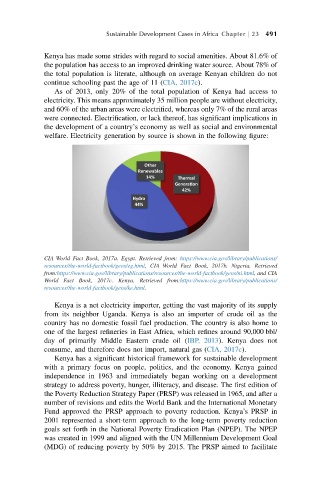Page 522 - Sustainable Cities and Communities Design Handbook
P. 522
Sustainable Development Cases in Africa Chapter j 23 491
Kenya has made some strides with regard to social amenities. About 81.6% of
the population has access to an improved drinking water source. About 78% of
the total population is literate, although on average Kenyan children do not
continue schooling past the age of 11 (CIA, 2017c).
As of 2013, only 20% of the total population of Kenya had access to
electricity. This means approximately 35 million people are without electricity,
and 60% of the urban areas were electrified, whereas only 7% of the rural areas
were connected. Electrification, or lack thereof, has significant implications in
the development of a country’s economy as well as social and environmental
welfare. Electricity generation by source is shown in the following figure:
Other
Renewables
14% Thermal
GeneraƟon
42%
Hydro
44%
CIA World Fact Book, 2017a. Egypt. Retrieved from: https://www.cia.gov/library/publications/
resources/the-world-factbook/geos/eg.html, CIA World Fact Book, 2017b. Nigeria. Retrieved
from:https://www.cia.gov/library/publications/resources/the-world-factbook/geos/ni.html, and CIA
World Fact Book, 2017c. Kenya. Retrieved from:https://www.cia.gov/library/publications/
resources/the-world-factbook/geos/ke.html.
Kenya is a net electricity importer, getting the vast majority of its supply
from its neighbor Uganda. Kenya is also an importer of crude oil as the
country has no domestic fossil fuel production. The country is also home to
one of the largest refineries in East Africa, which refines around 90,000 bbl/
day of primarily Middle Eastern crude oil (IBP, 2013). Kenya does not
consume, and therefore does not import, natural gas (CIA, 2017c).
Kenya has a significant historical framework for sustainable development
with a primary focus on people, politics, and the economy. Kenya gained
independence in 1963 and immediately began working on a development
strategy to address poverty, hunger, illiteracy, and disease. The first edition of
the Poverty Reduction Strategy Paper (PRSP) was released in 1965, and after a
number of revisions and edits the World Bank and the International Monetary
Fund approved the PRSP approach to poverty reduction. Kenya’s PRSP in
2001 represented a short-term approach to the long-term poverty reduction
goals set forth in the National Poverty Eradication Plan (NPEP). The NPEP
was created in 1999 and aligned with the UN Millennium Development Goal
(MDG) of reducing poverty by 50% by 2015. The PRSP aimed to facilitate

